The Urethane Blog
Everchem Updates
VOLUME XXI
September 14, 2023
Everchem’s exclusive Closers Only Club is reserved for only the highest caliber brass-baller salesmen in the chemical industry. Watch the hype video and be introduced to the top of the league: — read more
November 17, 2021
Huntsman’s Tony Hankins Inducted into UTECH Hall of Fame 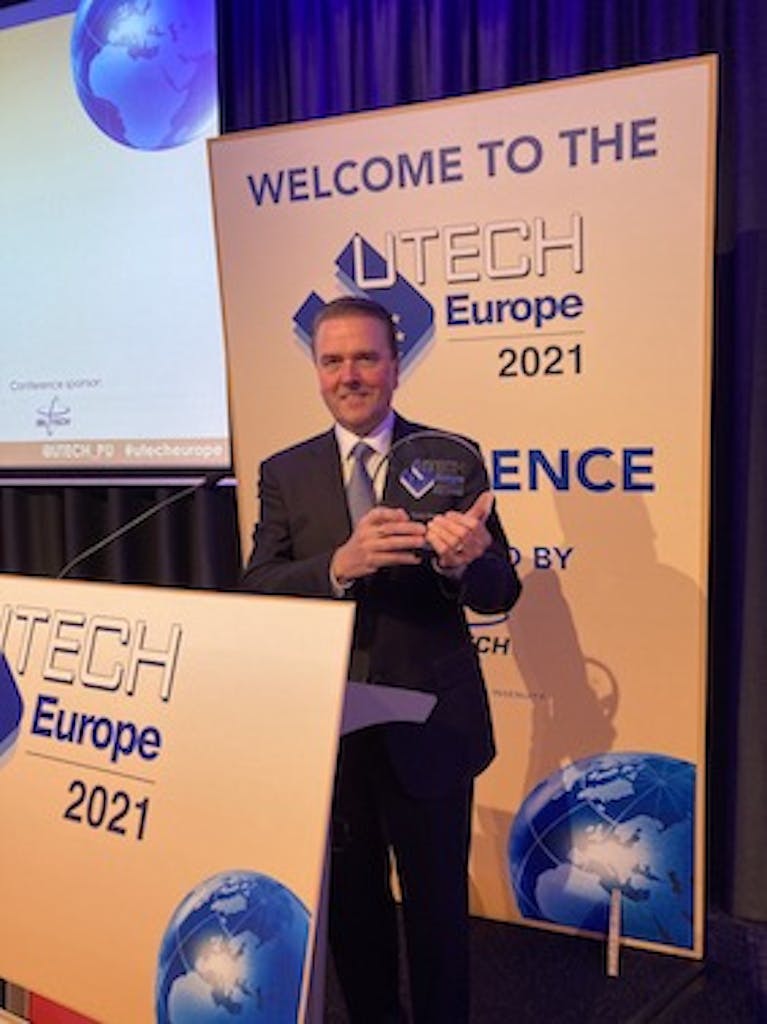
Maastricht, The Netherlands – On the opening day of the UTECH Europe Exhibition & Conference in Maastricht, The Netherlands, Tony Hankins, President of Huntsman’s Polyurethanes division, was inducted into the prestigious UTECH Hall of Fame.
At a special ceremony held on Tuesday 16 November, Tony Hankins joined a select group of senior polyurethane industry executives and thought leaders whose work in the world of polyurethanes is celebrated. The UTECH Hall of Fame recognizes leaders who have made a significant contribution to the global polyurethane industry and have spent at least 25 years working within the sector. Inductees are decided by an independent judging panel, which this year included representatives from Covestro, EUROPUR, ISOPA, Kingspan, Laaderberg, Polychemtech and Vitagroup.
Speaking at the event, Tony Hankins said: “I learned early in my career that the secret to longevity in this industry is to surround yourself with great people. So, I’d like to dedicate this award to the 4,000 employees in the Huntsman Polyurethanes business and thank them for their creativity and commitment. There are few industries in the world that are still going strong after 60 years; yet polyurethanes continues to enjoy sustainable growth. We undoubtedly have a bright future ahead.” Tony Hankins has worked in the polyurethanes industry for more than 30 years.
Huntsman’s global Automotive team was also shortlisted as a finalist in the UTECH Europe Automotive Awards for its ultra-low emission ACOUSTIFLEX® LE and RUBIFLEX® LE polyurethane-based foam systems for manufacturing sustainable car interiors.
November 17, 2021
Huntsman’s Tony Hankins Inducted into UTECH Hall of Fame 
Maastricht, The Netherlands – On the opening day of the UTECH Europe Exhibition & Conference in Maastricht, The Netherlands, Tony Hankins, President of Huntsman’s Polyurethanes division, was inducted into the prestigious UTECH Hall of Fame.
At a special ceremony held on Tuesday 16 November, Tony Hankins joined a select group of senior polyurethane industry executives and thought leaders whose work in the world of polyurethanes is celebrated. The UTECH Hall of Fame recognizes leaders who have made a significant contribution to the global polyurethane industry and have spent at least 25 years working within the sector. Inductees are decided by an independent judging panel, which this year included representatives from Covestro, EUROPUR, ISOPA, Kingspan, Laaderberg, Polychemtech and Vitagroup.
Speaking at the event, Tony Hankins said: “I learned early in my career that the secret to longevity in this industry is to surround yourself with great people. So, I’d like to dedicate this award to the 4,000 employees in the Huntsman Polyurethanes business and thank them for their creativity and commitment. There are few industries in the world that are still going strong after 60 years; yet polyurethanes continues to enjoy sustainable growth. We undoubtedly have a bright future ahead.” Tony Hankins has worked in the polyurethanes industry for more than 30 years.
Huntsman’s global Automotive team was also shortlisted as a finalist in the UTECH Europe Automotive Awards for its ultra-low emission ACOUSTIFLEX® LE and RUBIFLEX® LE polyurethane-based foam systems for manufacturing sustainable car interiors.
November 16, 2021
California Ports Defer Congestion Fee At The Last-Minute
by Tyler DurdenTuesday, Nov 16, 2021 – 02:40 PM
Authored by Greg Miller via FreightWaves.com,
Did ports defer fee plan because of progress or political peril?

It came down to the wire, but the highly controversial Los Angeles/Long Beach congestion fee is not happening — at least, not yet.
The ports were scheduled to begin charging ocean carriers $100 per import container starting Monday for boxes moving by truck that dwelled for nine or more days, and for boxes dwelling for six or more days that move by rail. The charge was scheduled to escalate by $100 a day until the container left the property.
The ports announced Monday that they will “delay consideration” of the fee until Nov. 22, citing a 26% reduction in long-dwelling containers since the plan was announced on Oct. 25.
“There’s been significant improvement in clearing import containers from our docks in recent weeks,” said Port of Los Angeles Executive Director Gene Seroka. According to Port of Long Beach Executive Director Mario Cordero, “Clearly, everyone is working together to speed the movement of the cargo and reduce the backlog of ships off the coast as quickly as possible.”
Political risks of fee plan
Another reason the ports may not have pulled the trigger: the political peril of doing so.
Carriers explicitly stated that they would pass the cost along to importers. As of Monday, Long Beach had 19,656 containers on its terminals that would have been charged the late fee. There were at least 29,249 containers that would have incurred fees at the Port of Los Angeles (not including containers moving by rail that were between six and nine days late, which are not included in the data).
That means the aggregate fees to all carriers on Monday alone would have exceeded $4.8 million. And because the proposed fee would increase daily, the aggregate cost would have quickly risen into the tens of millions per day, and would have likely topped $100 million per day by the end of the first week.
During a conference call on Friday, Hapag-Lloyd CEO Rolf Habben Jansen warned, “If there’s cargo in those boxes that is not very valuable, you may end up with a lot of abandoned cargo that is going to stay at the terminal for much, much longer.”
Consultant Jon Monroe wrote in his weekly newsletter, “While I understand the intention, this is really a dumb idea for one good reason: The ports cannot measure the days that the container has been available to deliver.
“Under the current conditions, when a terminal discharges a container, it puts a percentage of the containers into closed lanes,” Monroe explained.
“Whenever a container is in a closed lane, it is unavailable for pickup by the trucker. No appointment can be made. Depending upon the terminal, anywhere from 20% to 80% of the containers will be put into a closed lane for an amount of time that varies. It is not unheard of for containers to sit in a closed lane for weeks. How will the ports account for containers that are in closed lanes?”
In a letter to the Federal Maritime Commission sent Monday, 85 business associations including the National Retail Federation wrote, “We are especially concerned about the announcements by the carriers that they intend to pass the charges through to the cargo owners.”
The groups warned that the new fee, if implemented, would “add substantial costs to the supply chain” due to “ongoing challenges that many cargo owners and drayage trucking companies are experiencing with the ability to retrieve cargo because of port congestion, restrictive empty return policies, and subsequent chassis shortages that result.”
During the inaugural meeting of the National Shippers Advisory Council on Oct. 27, various members called the Los Angeles/Long Beach congestion fee plan “catastrophic,” “crazy” and “out of left field.”
Long way to go
The two port bosses cited significant progress with clearing the terminals, yet the numbers show that most of the gains occurred in late October and early November. In recent days, the numbers have actually gotten worse.
In the port of Los Angeles, the number of containers dwelling nine day or more on Monday was up 18% from where it stood on Saturday and was the highest since last Wednesday. The total number of containers on the port — 76,613 — is higher than the number on Nov. 4.

Chart: American Shipper based on data from Port of Los Angeles. Note: Containers dwelling six or more days that move by rail would also incur a fee.
According to Los Angeles’ data platform with Port Optimizer, 45% of containers at the APM Terminals facility were still past deadline, dwelling for nine days or more, as of Monday. The share of “late” containers was 40% at Everport Terminal Services and 48% at West Basin Container Terminal.

Charts: Port of Long Angeles, Port Optimizer
In the port of Long Beach, the number of containers that were past the time limit on Monday was up 14% from Saturday. The number is now higher than where it stood back on Nov. 6.
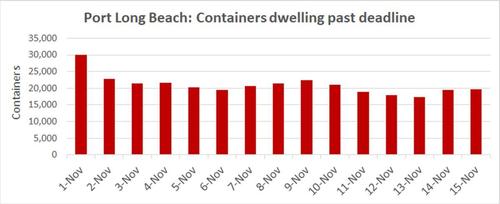
Chart: American Shipper based on data from Port of Long Beach. Note: containers past deadline include boxes moving by both rail and truck.
Meanwhile, cargo continues to flood into the two ports from the trans-Pacific trade lane.
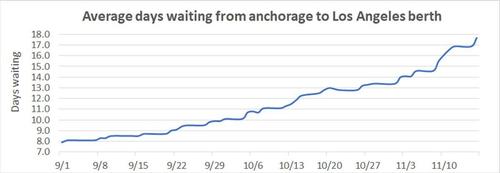
On Friday and Monday, yet another record was set for the number of container ships stuck at anchor or in holding patterns off the ports: 83. The average wait time at anchor for ships arriving in Los Angeles hit yet another fresh peak on Tuesday: 16.9 days.
November 16, 2021
California Ports Defer Congestion Fee At The Last-Minute
by Tyler DurdenTuesday, Nov 16, 2021 – 02:40 PM
Authored by Greg Miller via FreightWaves.com,
Did ports defer fee plan because of progress or political peril?

It came down to the wire, but the highly controversial Los Angeles/Long Beach congestion fee is not happening — at least, not yet.
The ports were scheduled to begin charging ocean carriers $100 per import container starting Monday for boxes moving by truck that dwelled for nine or more days, and for boxes dwelling for six or more days that move by rail. The charge was scheduled to escalate by $100 a day until the container left the property.
The ports announced Monday that they will “delay consideration” of the fee until Nov. 22, citing a 26% reduction in long-dwelling containers since the plan was announced on Oct. 25.
“There’s been significant improvement in clearing import containers from our docks in recent weeks,” said Port of Los Angeles Executive Director Gene Seroka. According to Port of Long Beach Executive Director Mario Cordero, “Clearly, everyone is working together to speed the movement of the cargo and reduce the backlog of ships off the coast as quickly as possible.”
Political risks of fee plan
Another reason the ports may not have pulled the trigger: the political peril of doing so.
Carriers explicitly stated that they would pass the cost along to importers. As of Monday, Long Beach had 19,656 containers on its terminals that would have been charged the late fee. There were at least 29,249 containers that would have incurred fees at the Port of Los Angeles (not including containers moving by rail that were between six and nine days late, which are not included in the data).
That means the aggregate fees to all carriers on Monday alone would have exceeded $4.8 million. And because the proposed fee would increase daily, the aggregate cost would have quickly risen into the tens of millions per day, and would have likely topped $100 million per day by the end of the first week.
During a conference call on Friday, Hapag-Lloyd CEO Rolf Habben Jansen warned, “If there’s cargo in those boxes that is not very valuable, you may end up with a lot of abandoned cargo that is going to stay at the terminal for much, much longer.”
Consultant Jon Monroe wrote in his weekly newsletter, “While I understand the intention, this is really a dumb idea for one good reason: The ports cannot measure the days that the container has been available to deliver.
“Under the current conditions, when a terminal discharges a container, it puts a percentage of the containers into closed lanes,” Monroe explained.
“Whenever a container is in a closed lane, it is unavailable for pickup by the trucker. No appointment can be made. Depending upon the terminal, anywhere from 20% to 80% of the containers will be put into a closed lane for an amount of time that varies. It is not unheard of for containers to sit in a closed lane for weeks. How will the ports account for containers that are in closed lanes?”
In a letter to the Federal Maritime Commission sent Monday, 85 business associations including the National Retail Federation wrote, “We are especially concerned about the announcements by the carriers that they intend to pass the charges through to the cargo owners.”
The groups warned that the new fee, if implemented, would “add substantial costs to the supply chain” due to “ongoing challenges that many cargo owners and drayage trucking companies are experiencing with the ability to retrieve cargo because of port congestion, restrictive empty return policies, and subsequent chassis shortages that result.”
During the inaugural meeting of the National Shippers Advisory Council on Oct. 27, various members called the Los Angeles/Long Beach congestion fee plan “catastrophic,” “crazy” and “out of left field.”
Long way to go
The two port bosses cited significant progress with clearing the terminals, yet the numbers show that most of the gains occurred in late October and early November. In recent days, the numbers have actually gotten worse.
In the port of Los Angeles, the number of containers dwelling nine day or more on Monday was up 18% from where it stood on Saturday and was the highest since last Wednesday. The total number of containers on the port — 76,613 — is higher than the number on Nov. 4.

Chart: American Shipper based on data from Port of Los Angeles. Note: Containers dwelling six or more days that move by rail would also incur a fee.
According to Los Angeles’ data platform with Port Optimizer, 45% of containers at the APM Terminals facility were still past deadline, dwelling for nine days or more, as of Monday. The share of “late” containers was 40% at Everport Terminal Services and 48% at West Basin Container Terminal.

Charts: Port of Long Angeles, Port Optimizer
In the port of Long Beach, the number of containers that were past the time limit on Monday was up 14% from Saturday. The number is now higher than where it stood back on Nov. 6.

Chart: American Shipper based on data from Port of Long Beach. Note: containers past deadline include boxes moving by both rail and truck.
Meanwhile, cargo continues to flood into the two ports from the trans-Pacific trade lane.

On Friday and Monday, yet another record was set for the number of container ships stuck at anchor or in holding patterns off the ports: 83. The average wait time at anchor for ships arriving in Los Angeles hit yet another fresh peak on Tuesday: 16.9 days.
November 15, 2021
Polyurethane Foam Association Fall Meeting Provides Forum For
Issues Discussion, Technical Advances
Edge-Sweets Company and James T. McIntyre, Jr. Inducted Into The Flexible Polyurethane
Foam Hall Of Fame
CHARLOTTE, NC (November 12, 2021)—The Polyurethane
Foam Association (PFA) recently concluded its fall meeting,
which spotlighted key regulatory issues and new technical
developments.
PFA’s two-day meeting in early November was attended by
more than 130 executives from foam manufacturers, chemical
suppliers, and other companies supporting the industry. This
marked a return to a full live-meeting format after COVID-19
restrictions required PFA to cancel past meetings or conduct
them primarily online.
Attendees saw presentations on key industry issues including
supply chain challenges, recycling, regulations, and end-user
market forecasting.
Keynote speakers, identical twins Terrence and Lee Resnick of
Resnick Associates, provided attendees with financial advice on
company succession issues and potential tax law changes.
In addition, a Technical Program featured presentations on
innovations and best practices on topics ranging from new mold
release agents and additives to reduce foam compression set, to
plant safety, new equipment, and new additives for improved
foam production.
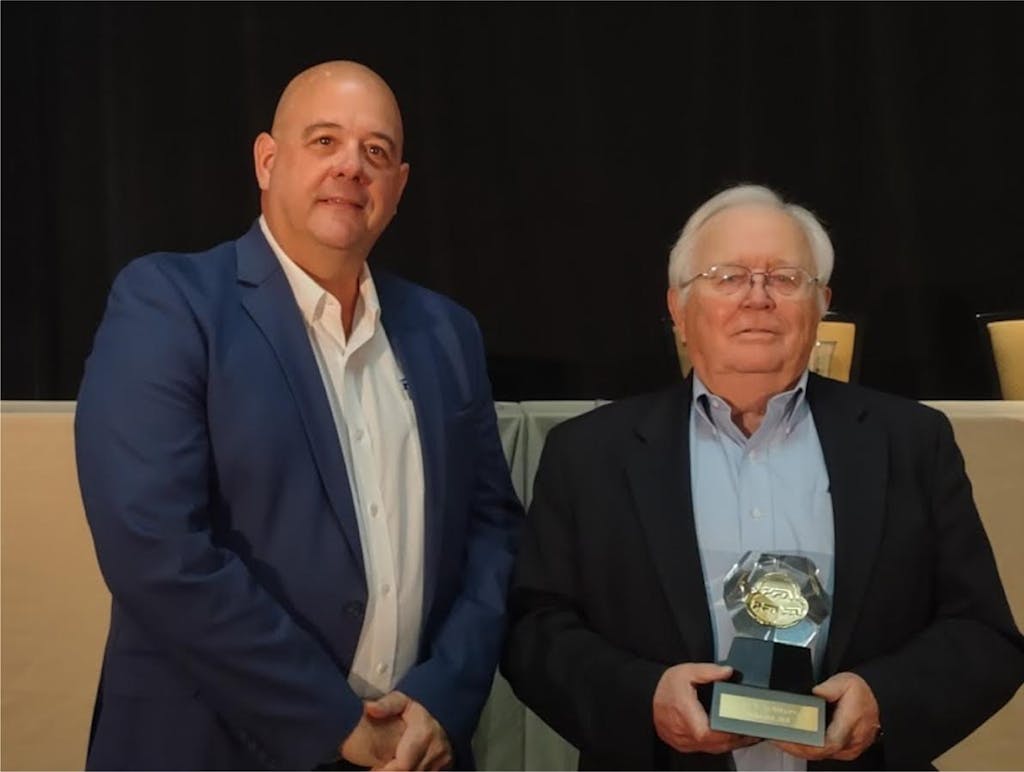
2021 Flexible Polyurethane Foam Hall
of Fame Inductees, James T. McIntyre
(top right), pictured with PFA President
Chip Holton of NCFI Polyurethanes;
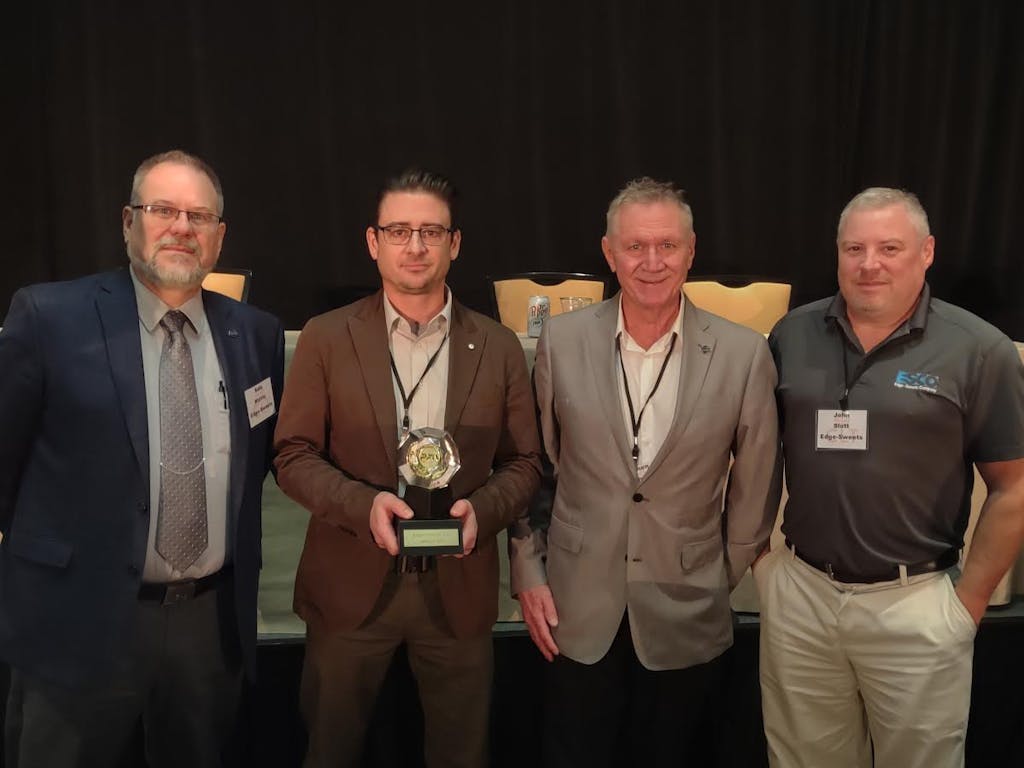
and Edge-Sweets Company (ESCO).
Accepting for ESCO were President
Richard Hungerford, Jr.(holding award)
with (L to R) Kelo Waivio, Stephen
Hoffman, and John Slott.
Mark McBride and Willie Wesley III of BASF won the Dr. Herman Stone Technical Excellence
Award, as their presentation, “Recent Advances In Flexible Foam,” was voted best by those
attending the Technical Program. “After four decades in this industry, I am still impressed by the
level of innovation that continues in flexible polyurethane foam,” noted Bill Gollnitz, Past
President of PFA and Moderator for the Technical Program. “Congratulations to Mark and
Wesley—and to our other presenters—for exceptional work.”
As part of its 40 th Anniversary celebration, PFA also recognized one manufacturer and one
individual for induction into the Flexible Polyurethane Foam Hall Of Fame. The Hall of Fame
was established to honor the leaders and innovators of the industry. It serves as an information
source for future industry members and researchers regarding the contribution of individuals and
companies who have significantly contributed to the growth and betterment of the flexible
polyurethane foam industry in North America.
The two 2021 inductees were Edge-Sweets Company (ESCO) and James T. McIntyre, Jr.
ESCO produces highly specialized machines for cutting and processing polyurethane foams.
With its engineer-to-order approach, ESCO’s is unique in its abilities to meet customers’
requirements using modern manufacturing technologies, 3D modeling software and finite
element analysis. The company is the product of a merger between The Edge Company of Grand
Rapids, MI and the Martin Sweets Company of Louisville, KY.
The company has manufactured products for industries including furniture and upholstery,
bedding, packaging, industrial insulation, oil and gas, building and construction, automotive,
marine, medical, defense, mining, and aerospace.
“ESCO has long been a supporter of PFA and the flexible foam industry,” said Chip Holton of
NCFI Polyurethanes, PFA’s President. “ESCO’s efforts in innovation, customer service, and
education made the company a more-than-worthy candidate to join other great manufacturers in
the Flexible Polyurethane Foam Hall of Fame.”
James McIntyre, Jr. of the McIntyre & Lemon Law Firm in Washington, DC, has served as
PFA’s Legal Counsel from the beginning of the association. Prior to his private law practice, he
served in the Cabinet of President Jimmy Carter as the Director of the Office of Management and
Budget. He also served as Director of the Office of Planning and Budget for the State of Georgia.
President Reagan appointed him to his Commission on Privatization.
McIntyre has helped guide the flexible polyurethane foam industry through a variety of
regulatory challenges through his four decades of service, providing PFA members with
consistent, insightful legal representation. “It is safe to say that the flexible foam industry would
look a lot different today without the efforts of Jim McIntyre,” said Holton.
The Polyurethane Foam Association is a trade association founded in 1980 to help educate foam
users, allied industries and other stakeholders. PFA provides facts on environmental, health and
safety issues and technical information on the performance of FPF in consumer and industrial
products. FPF is used as a key comfort component in most upholstered furniture and mattress products, along with automotive seating, carpet cushion, packaging, and numerous other
applications.
#
www.pfa.org
